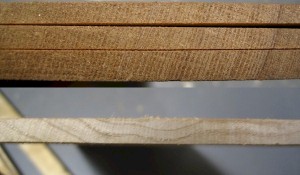Now, in contrast with the back, the top has the important job of transferring the strings vibrations, and passing them on to the rest of the instrument. I think of the top as only a passer, and the back as the one that holds the sound. (Though we can use different kinds of passers to influence what type of sounds are being transferred.) For this job, we try to employ the lightest wood possible, (usually a softwood such as cedar or spruce), so that as little of the vibrations as possible are held by the soundboard, but are instead passed on to the rest of the instrument’s body. The more of these vibrations that can fully reach and sound over the entire body of the psaltery, the fuller the sound will become – at least in theory.
Here is my theory as to why some instrument builders use hardwoods for the top:
The sides are so thick, that so little vibrations make it to the back anyway. Accordingly, the job of the back (holding the vibrations) is instead accomplished by the top. The back becomes almost irrelevant, and the whole flow of vibrations is contained mainly within just the top and sides. The big drawback to all of this is that the depth of the tone is greatly compromised. The tone of the strings sounds good, but it is also shallow. It is like a beautiful photograph: it looks good, but it is only two-dimensional with no depth.
Anyhow, that is only my theory! My building philosophy is much different: I want all the strings’ vibrations to shoot down throughout the entire body of the instrument, maximizing the eventual projection of these vibrations out of the soundhole. I go about pursuing this goal and adjusting my building plans in a few different ways; the main ways include minimizing the thickness of the sides, and using a wood of low mass for the top.
As a side-note to all of this, even the Israelites from thousands of years ago knew to use wood of a low mass for building their musical instruments! I found this interesting: (fir is very similar to spruce and pine)
“And David and all the house of Israel played before the LORD on all manner of instruments made of fir wood, even on harps, and on psalteries, and on timbrels, and on cornets, and on cymbals.” -2 Samuel 6:5
Now, as a balance to this, we also need a piece of wood that is strong enough to hold up to the pressure created from all 25 of the strings. In other stringed instruments, this usually involves bracing the soundboard in one way or another. With a bowed psaltery, most builders chose to simply position the bridge close to the pinblock, with the bridge ends also resting on the sides of the instrument for added support.
But closely related to strength is also stability. Wood absorbs and releases moisture in the air depending on the humidity level until an equilibrium is reached. When the wood absorbs moisture, it expands, when it loses moisture, it contracts.
Quartersawn wood is wood that has been cut with the tree’s growth rings running at 90 degrees vertical (or close to it) when viewed on the end, while flat-sawn wood can have the growth rings in just about any orientation that happens to come up when cutting a log – usually a lower angle.

Because of the way that wood gains and loses moisture, the orientation of the growth rings plays a major part in the wood’s stability. Along its width, quartersawn wood expands only about half as much as flat-sawn wood. Also, for quartersawn boards, the manner in which it expands is also very uniform – it tends to stay flat. Conversely, flat-sawn boards move unevenly, and can twist and cup. This is most dramatic and pronounced in thinner woods – such as the ones used for soundboards.
In making musical instruments, these changes may be very slight – maybe even undetectable to the eye at times – but to the wood, it is very critical. The back of the psaltery can deform or warp slightly under adverse conditions if it is flat-sawn. But if the top tries to shrink, expand, or warp – with the bridge bearing down on it – the wood is doubly stressed and may crack.
Because of this, quartersawn wood is almost always used for the tops of acoustic musical instruments.

thank you for the info I have a Giannini which needs a new top my luthier friend would like to use a piece of 100 year old pine he has and I was worried but after reading youre post I think it will be fine when properly braced yes\no? shawn
I am a bit confused by your question? What were you thinking would be problematic about using pine for a soundboard?
well its just I personally had never heard of pine for such I suppose all coniferous trees would work